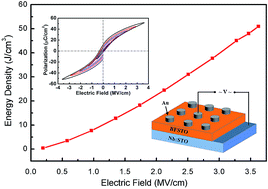BiFeO3–SrTiO3 thin film as a new lead-free relaxor-ferroelectric capacitor with ultrahigh energy storage performance
Abstract
Capacitors with high electrostatic energy density, long-term stability, and environmental friendliness are strongly demanded in modern electrical and electronic systems. Here, we obtained a new lead-free relaxor-ferroelectric Mn-doped 0.4BiFeO3–0.6SrTiO3 (BFSTO) thin film capacitor with an ultrahigh energy density of ∼51 J cm−3, which is superior to other lead-free systems and comparable with the best lead-based films. The breakdown strength of the BFSTO film reached ∼3.6 MV cm−1. Besides, the thin film capacitor showed strong fatigue endurance after 2 × 107 cycles and possessed good thermal stability of energy storage performance in a wide temperature range (−40–140 °C). These excellent features should be ascribed to the good epitaxial quality, strong relaxor behavior, and suppressed leakage current of the film. The results prove the great potential of the BFSTO film for electrostatic energy storage. More importantly, our findings could motivate the design and fabrication of a series of BiFeO3-based dielectrics with suppressed leakage currents and high breakdown strength to develop a new kind of lead-free dielectric material with ultrahigh energy storage performance.



 Please wait while we load your content...
Please wait while we load your content...